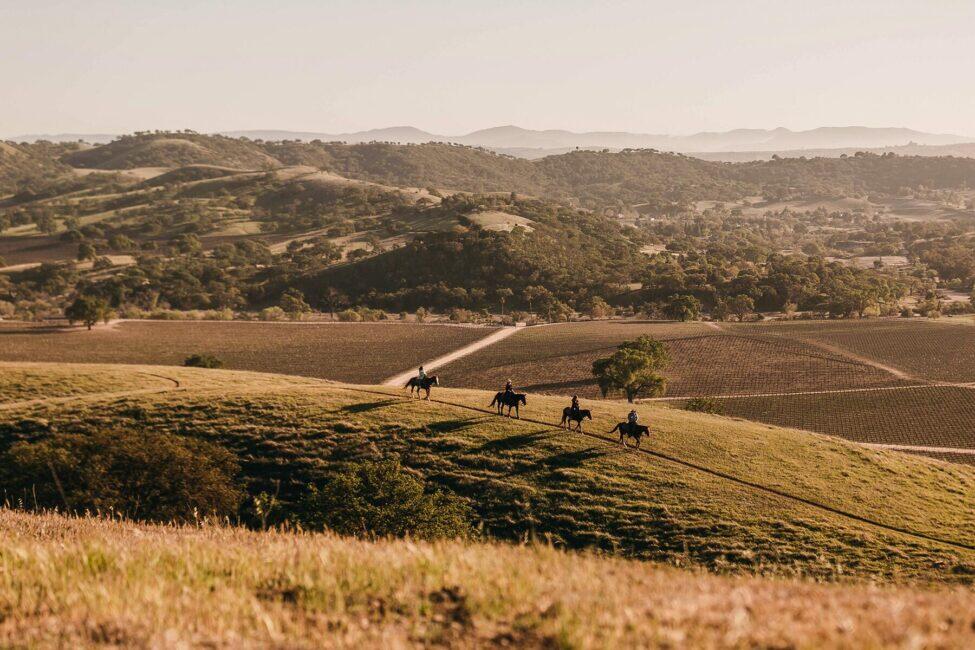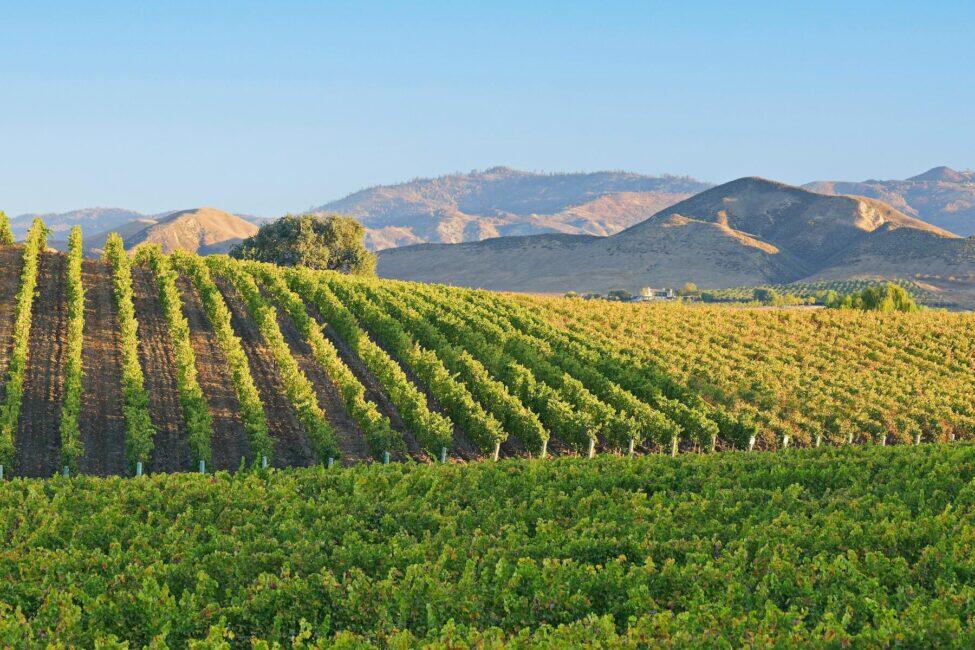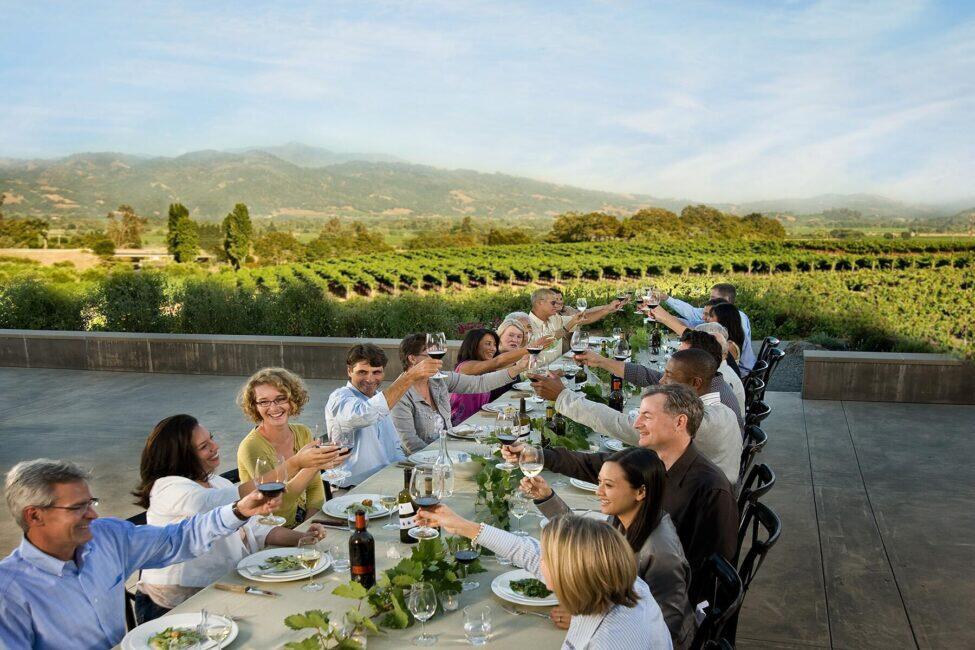Will Napa, Sonoma, Paso Robles, or Santa Barbara meet your grape expectations?
When it comes to wine, California is kind of a big deal.
The state boasts 6,200 wineries fermenting, blending, and bottling 229 million cases of wine. One hundred varietals are grown across 610,000 acres within 154 recognized AVAs (American Viticultural Areas). A massive 80% of the country’s annual supply comes from Cali, making it the world’s fourth-largest winemaking region. It’s also big on quality, especially the full-bodied crimson beauties conjured from the state’s most widely grown grape, Cabernet Sauvignon.
California wine also happens to be even better when tasted at the source. There’s something special about being surrounded by rolling hills of vineyards, overlooking the Pacific, or hanging out with a winemaker in a cave, a rehabbed barn, or an olive tree-dotted courtyard – ideally with a plate of local charcuterie or a Michelin-starred feast. It’s more fun when you go between winery appointments by bike (Sonoma Valley Bike Tours), horse (Vino Vaqueros), electric tuk-tuk (Laces + Limos) or even motorcycle sidecar (Third Wheel Tours). (In fact, here are 20 California wineries that are a guaranteed good time.)
It’s easy to understand why every year, more than 20 million thirsty travelers take the Petit Verdot pilgrimage to one of California’s wine countries, and millions more have it on their bucket list. But when dealing with numbers like these, trying to decide which drinking destination to visit – even when narrowed down to the four most prominent regions: Napa Valley, Sonoma County, Santa Barbara County, and Paso Robles – can become overwhelming.
Continue Reading Article After Our Video
Recommended Fodor’s Video
It’s why people are constantly asking Evan Hufford, co-owner of Sonoma County wine bar Maison Healdsburg, where they should go first. Thankfully, he’s developed a two-question system to answer it.
“Well, first I’d be remiss if I didn’t lead with Sonoma because that’s where we own a wine bar and it’s an enormous grab bag of wildly different wines,” Hufford jokes before adding, “In all honesty, there’s good wine all over California, but different regions offer different wines and vibes and the decision is one of personal preference. So I ask, ‘What kind of wine do you usually like to drink,’ and ‘What kind of experience do you want to have?’”
We stole Hufford’s swirling questions to create this guide, designed to help deduce which of California’s fantastic four is the wine country for you.
Napa Valley: Best for Red Wine Lovers
Best Pours: Big Bold Cabernet Sauvignons, Chardonnay
Number of Wineries: 400+
Even for the most novice wine drinkers, Napa’s revered reputation precedes itself. Sandwiched between two mountain ranges with a dry Mediterranean-style climate, 33 soil types, and 17 sub-appellations, Napa’s viticultural story begins with making sacramental wines for missions. It gained commercial steam in the late 1800s when wineries like Charles Krug, Beringer, and Inglenook were established – all of which still operate today. However, its global esteem was cemented with the 1976 Judgement of Paris blind tasting when Stag’s Leap Wine Cellars and Chateau Montelena outranked French Cabernet Sauvignon and Chardonnay.
The valley gets more prestigious and posher by the day, which, of course, comes with a steeper price tag. Napa is where you go if money is no object, you’re celebrating something special, or you want to stoke FOMO on your socials with stays in vineyard-hugging luxury resorts like Four Seasons Napa Valley, multi-course meals at Michelin-starred restaurants including French Laundry or Kenzo, steamy milk baths in Meadowood’s hand-hammered copper tubs, and tastings at grand old estates or newer wineries like Bella Union and CADE Estate. Entry-level tastings regularly cost more than $100 per person and climb as you add food pairings, activities, estate tours, or fancy transportation. For example, Shafer’s $500 Hillside Select Experience, which includes caviar, a Polaris Ranger tour of the grounds, and a seated vertical tasting. Theorem teamed up with Baccarat for a $750 tasting that pairs a winery tour, high-elevation estate vintages, a winemaker- and chef-curated menu using ingredients from Theorem’s Diamond Mountain gardens and Montana ranch, and an engraved crystal glass souvenir. If you have $30,000 to spare, indulge in Bardessono Hotel & Spa’s package, which includes four nights in a villa, in-suite wine and food pairing, a class on how to taste like a master sommelier, and two winery tastings.
Paso Robles: Best for Western Vibes and Creative Winemakers
Best Pours: Old Vine Zinfandel, Cabernet Sauvignon, Gsm Blends
Number of Wineries: 200+

Equidistant from Los Angeles and the Bay Area, Paso Robles, arguably the fastest growing wine region in the state, has been called wine’s “melting pot.” Like Napa, there’s a lot of excellent Cabernet here—DAOU, Austin Hope, or Booker to name a few—but unlike Napa, it isn’t Paso’s whole personality. More than 60 varietals are grown on more than 40,000 acres that fall under one eponymous American Viticultural Area, which is further divided into 11 sub-AVAs due to sundry temperatures, terrains, and terroirs.
Plenty of wineries along the dusty, windy country roads cling to old-world ways to make impressive wines influenced by France’s three most famed regions—Rhone, Bordeaux and Burgundy—as well as Spanish and German hits like Gewürztraminer and Albariño. But numerous others, including Paix Sur Terre, Herman Story, and Tablas Creek (they’ve got a llama on staff!) are geeked to experiment with kooky labels, unconventional techniques, and rarer varietals like Counoise, Négrette, Cinsault, Ugni Blanc, Roussanne, Picpoul and Vaccarese, creating unique blends that shine in the glass. Thacher’s Funky Fridays offer deep dives into the unconventional. Taste at huge sweeping properties topping undulating hills (JUSTIN), a repurposed industrial village of tiny-batch hustlers like Hubba called Tin City, or stand-alone tasting rooms around downtown. Regardless of which of sipping scenario you’re drawn to, the barrier to entry is fairly nonexistent – walk-ins are welcome, tastings average $40, and fees are usually waived when you buy bottles.
That inviting, never-snooty spirit spills over into the community-driven small town with a central square at its heart. It’s a mix of modern (i.e., light art installation Sensorio) and nostalgic (annual Mid-State Fair, Alta Colina’s collection of ‘50s and ‘60s trailers for rent). Jeans and boots are welcome at even the fanciest restaurants like Les Petites Canailles or Six Test Kitchen. There’s a strong reverence for Paso’s agricultural and ranching past and present. Nods to it can be found everywhere, from old barns converted into tasting rooms and cowboy bars like Cattlemen’s Lounge, to FARMstead ED, a family-friendly trail of hands-on experiences, u-pick farms, and farmers’ markets. Several popular lodging and dining options (Stables Inn, Cowgirl Café, Farmhouse, and Grace and Rose) favor updated western or ranch house décor, and you can even ride horses at Ancient Peaks Winery.
Santa Barbara: Best for Sipping Small Oceanside
Best Pours: Chardonnay and Pinot Noir
Number of Wineries: 300+

Thirsting for a quintessential California fun-in-the-sun beach adventure and a wine country weekend? Quench both needs simultaneously with a retreat to the American Riviera and the vine-covered countryside of Santa Barbara County. It contains seven AVAs, growing 75 types of grapes, and was the bucolic setting of the Oscar-winning Merlot-bashing midlife-crisis film Sideways. In the 20 years since the movie was made, a lot has changed in terms of the number of players, the amount of money backing its wine industry, and the greatly enhanced tourist experience with new hotels like Hotel Ynez or budget-friendly The Hadsten Tapestry Collection By Hilton and acclaimed restaurants like Bell’s in Los Alamos or Buellton’s Na Na Thai.
What hasn’t changed is its unique formative geographical feature—a transverse mountain range running east-west instead of the usual north-south, which sends cooling fog and Pacific winds into the canyons where they stick to the slopes and add intense minerality to the soil. The scene is still dominated by small family-owned producers charging $30 for a tasting, like Bien Nacido Estate, Whitcraft, and Star Lane Vineyard.
Santa Barbara is beloved for its proximity to the coast, laidback ambiance, hot sunny summers, mild Mediterranean-style winters, gorgeous sunsets, and easy access to fresh seafood, including world-famous spot prawns, sea urchins, and rockfish. Sixteen wineries and tasting rooms, including The Valley Project, Pali Wine Co., and Melville, are located in the Funk Zone, a rehabbed industrial zone within a block of the sand. It’s chock-full of trendy restaurants, places to stay (Hotel Californian,) and street art. Put the tan in tannins on a wine-tasting boat tour or by lingering with a flight on the beautiful sun-dappled patios of Folded Hills (they have animals to pet!) or Presqu’ile (combine horseback riding, Rosé, and a gourmet picnic!). Cap off your visit with a “Sense Of Place” pairing at Michelin-starred Caruso’s, featuring a seaside supper and SBC wine menu.
Sonoma County: Best for Oenophiles Who Love the Outdoors
Best Pours: Pinot Noir, Sauvignon Blanc, Bubbles
Number of Wineries: 425+

Although Sonoma and Napa are only an hour apart by car, they’re wildly different places to drink. Emphasis on wild. As Hufford (our Sonoma bar owner and wine expert) mentioned, that adjective applies to the wine itself. Covering 1,768 square miles, 60 varietals are grown across Sonoma County’s 19 AVAs, incorporating a wide spectrum of landscapes, including the foggy Russian River Valley, the maritime-influenced West Sonoma Coast, the volcanic soils of Chalk Hill, and the windy coastal corridor known as the Petaluma Gap. That diversity results in everything from Alexander Valley’s big reds (Aperture Cellars) and Los Carneros’ cool-climate sparkling Chardonnays to Zinfandels with spicy berry notes and complex finishes.
It also applies to the overall experience, which retains an undercurrent of Northern California’s hippie and outdoorsy roots. Almost 75% of the vineyards are certified sustainable, organic, or biodynamic, including Medlock Ames, which created an immersive sound exploration and tasting combo. Even in the sophisticated hamlet of Healdsburg, with its central plaza lined with galleries and fancy eats like Valette, eco-friendly businesses abound. Check out LEED Gold-certified Harmon Guest House, the Marine Layer tasting room, which often offers a vegan food pairing, and plant-based Little Saint, a farm, café, live music venue, and bar that focuses on closed-loop cocktails to reuse kitchen scraps.
There’s no shortage of ways to spend time imbibing naturally. Jenny Harrow-Keeler leads therapeutic forest bathing coupled with tastings for Bartholomew Estate Winery and Red Car Wine Co. – Zephyr Farms Vineyard. Unroll your yoga mat at Vinarosa Resort & Spa, Bricoleur Vineyards or Hook & Ladder Winery for Vinyasa among the vines. Take a foraging class at Timber Cove Resort, culminating in a meal using what you found. Taste, kayak, and cycle on Getaway Adventures’ Pedal ‘N Paddle tour. Work up a thirst hiking around Jordan Vineyard, Bella Vineyards (through Hotel Healdsburg package), or dog-friendly Kunde Family Winery.
The wide array of glamping accommodations – including Guerneville’s River Electric, which sits on 12 acres of meadows and redwood groves, or Dawn Ranch’s tents in a heritage apple orchard – keeps the alfresco ambiance going.

